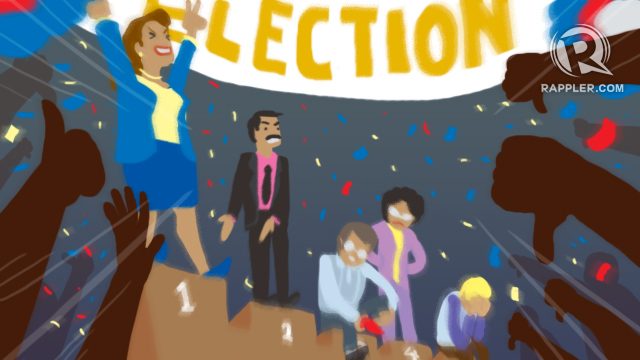SUMMARY
This is AI generated summarization, which may have errors. For context, always refer to the full article.

In the 1992 presidential election in the Philippines, Fidel Ramos won with a plurality of only 23.6% of the vote. This occurred as the vote for president was split among 7 candidates. In one interpretation, he was therefore rejected, or at least not strongly supported, by over 3 quarters of the electorate.
In the country’s subsequent 3 elections, the winners declared victory on the basis of much more decisive pluralities: Joseph Estrada with nearly 40% in 1998; Gloria Macapagal Arroyo with roughly 40% in 2004; and Benigno Aquino III with a bit more than 42% in 2010. They achieved this even as they emerged from relatively large pools of well-known candidates (8 in 2004, 5 in 2004, and 6 in 2010).
Now it looks as if the May 2016 elections may bring results similar to 1992. Based on the polling data thus far, a winner could potentially emerge with a relatively small plurality. There are 5 candidates, 4 of whom have registered at least 20% in major opinion polls.
Unrepresentative results
The Philippines is not alone in having candidates win on the basis of modest pluralities in multi-candidate races. In the current Republican primaries in the United States, Donald Trump is “winning” in a divided field with roughly a third of the vote. But polls show that he is also deeply disliked by most Republican electors, meaning that he may struggle to represent the party as a whole.
These results highlight a perennial problem of “first-past-the-post” or “plurality” voting, a system where the candidate with the most votes wins the election. In situations where several candidates split the vote, a broadly unpopular candidate who nonetheless has a strong core of support can emerge victorious.
What can be done to prevent such possibly unrepresentative results?
Second-round election

One possible solution is to institute a system of “run-off” elections. Such a system kicks into place if no-one wins a majority of the vote or more than 50%. When this happens, the best-placed candidates compete in a second-round election.
The most common method is for the second round of voting to be a straight contest between the two highest vote-winners from the first round. This produces a true majority result, in that one of the two candidates will necessarily achieve more than 50% of votes and be declared the winner.
Runoff systems are commonly used around the world, especially for electing presidents. Indeed, only a few countries have the same practice as the Philippines in using a single-round plurality vote to elect their president. These countries are mainly in Africa: Kenya, Zambia, Malawi, and Zimbabwe.
Most countries in Europe, by contrast, use a second round of voting to ensure a majority winner. France, Finland, Austria, Bulgaria, Portugal, Poland, and the Ukraine are examples. In Asia, Indonesia and Timor-Leste use run-off systems to elect their presidents. Argentina, Chile, Brazil, Ecuador, and Peru are among the many Latin American countries that use a second round to elect the president.
France has long experience with a run-off system, and its most recent presidential election, in 2012, helps to illustrate how the system works. In the first round, François Hollande came in first place with 28.6% of the vote, followed by Nicolas Sarkozy with 27.2%. Three other major candidates garnered roughly 18%, 11%, and 9% of the vote. As Hollande fell short of a 50% majority, he then faced Sarkozy in a run-off election held two weeks later. In the second-round election, Hollande defeated Sarkozy by a margin of 51.6% to 48.4% of the vote.
Variations of the run-off system
In most countries, a 50% threshold applies. But other countries use a variation on this model.
In Costa Rica, a candidate can win on the first round with only 40% of the vote.
Conversely, in Sierra Leone, a second round is only avoided if one candidate gets 55% in the first.
In Argentina, there are two ways in which a candidate can be successful in the first round. One alternative is to poll at least 45%. The other path to success is to poll at least 40% and at the same time register more than a 10%-lead over the second-placed candidate.
An additional type of run-off system is found Indonesia. As described in the International IDEA Electoral Design Handbook, this is based on an explicit goal of ensuring that successful candidates “have sufficient support across a large and diverse country”:
For a ticket to be elected on the first round, it must not only poll an absolute majority of votes cast but also meet a distribution requirement of 20% of the vote in at least half the provinces. While a majority winner will almost certainly achieve this, the requirement prevents a ticket whose support is solid in highly populated Java and minimal elsewhere from winning an election in the first round. In the first direct presidential election in 2004, 5 tickets contested the first round in July, with none polling over 35%; in the second round in September, Susilo Bambang Yudhoyono gained victory with 61% of the votes.
In the subsequent two Indonesian elections, by contrast, there was no need to go to a second round. In 2009, Yudhoyono won in the first round with 61% of the vote. Five years later, in 2014, Joko Widodo had a first-round victory with 53% of the vote.
Advantages and disadvantages
If the Philippines were to consider going to a run-off system, it is important to consider both the disadvantages and the advantages.
To be sure, runoffs have disadvantages: the system places considerable pressure on the electoral administration by having to run a second election a short while after the first. This significantly increases the cost of the overall election process and the time-period between the holding of an election and the declaration of a result. It can lead to instability and uncertainty.
Having a second round of voting also places an additional burden on the voter, and sometimes there is a sharp drop in turnout between the first round and the second.
The system does, however, have a number of powerful advantages.
First and foremost, it allows voters to have a second choice if their chosen candidate does not make it through to the second round. They can even change their minds on their favored choice between the first and the second rounds.
Secondly, it encourages diverse interests to coalesce behind the successful candidates from the first round in the lead-up to the second round of voting, thus encouraging bargains and trade-offs between parties and political groupings and candidates. It also enables the parties and the electorate to react to changes in the political landscape that occur between the first and the second rounds of voting.
The most important benefit of run-off voting systems, however, is that they substantially lessen the problems of “vote splitting” – the common situation under first-past-the-post elections where political groupings with broadly similar perspectives “split” their combined vote between them, thus allowing a less popular candidate to win the seat.
This is a particularly serious problem in cases, such as the Philippines since 1986, where there are commonly a large number of candidates representing an array of political groupings and clans. This is in contrast to pre-martial-law Philippine politics, between 1946 and 1972. At that time, the presence of a fairly stable two-party system tended to mean fewer candidates contending for the presidency and vice presidency.
Run-off systems avoid this pitfall of “vote splitting” and the related problem of a president wielding vast influence on the back of a minority of the voters. In the wake of a run-off election, the new president is elected with a much stronger popular mandate. – Rappler.com
Professor Benjamin Reilly is dean of the Sir Walter Murdoch School of Public Policy and International Affairs at Murdoch University in Perth, Australia.
Read the other articles in the “Elections: What PH can learn from the world” series:
Add a comment
How does this make you feel?
There are no comments yet. Add your comment to start the conversation.